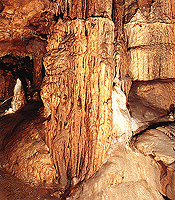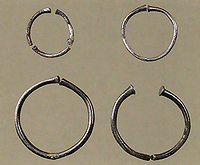 


Alepotrypa Cave is situated in the deep sheltered Gulf of Diros in western Mani. It has an elongated form (280 metres long) and consists of large chambers with a flat surface, but which succeed each other with a small difference in height. In the larger chamber (100X60 metres) there is a lake with potable water and a maximum depth of 14 metres. The cave was in use at least from the beginning of the Early Neolithic (5300 BC) and for a period of approximately 2000 years. At the end of the Final Neolithic (3200 BC), a severe eathquake occurred sealing the entrance of the cave and the life of its inhabitants inside. Speleologists N. and A. Petrocheilos, who located the cave in 1958, discovered their remains. Archaeological investigations during the 1970s produced evidence that
there was habitation of both the interior, but also of the wider cave
area. Its lateral niches formed the living quarters of Neolithic families
and hearths, radially defined by stones, small ovens and storage pits
dug on the floor of the cave chambers, seem to have served the whole
community. |

An important boost to the economy of the community was given by sea communications which intensified in the Aegean from the end of the Late Neolithic and especially during the Final Neolithic. We can infer from the presence of tools of Melian obsidian, the practice of metallurgy and the ownership of silver jewellery that an intensification in economic and cultural exchanges occurred, that gradually brought about social differentiation as well. Finally, in the cave niches the dead members of the community were also laid. Special respect was expressed to them as indicated both by the offer of funerary gifts, and by the collection of skulls (ossuary of 19 skulls). A high mortality rate in children has been observed, while the average life expectancy was less than 35 years. This has been attributed to the unhealthy and unbalanced diet of the cave's inhabitants, the symptoms of which were anaemia, arthritis, malaria, dental decay etc., ascertained by an examination of the skeletons. |